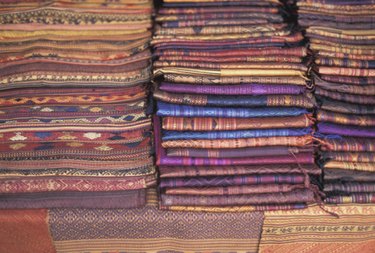
Located on the Ganges River, the Indian city of Bhagalpur is known as Silk City. By the 7th century, Bhagalpur was recognized as a trading hub, but the silk industry is barely 200 years old. A prominent institution in Bhagalpur, the Silk Institute provides training and education in the silk trade. Although Tussah or Tusser silk is the best-known product of the area, Matka silk is also woven in the region.
The Birth of Silk
Video of the Day
Making silk is a delicate process and takes a number of steps. The first step is sericulture, which is the silk worm cultivation. Maintained in a controlled environment, the worms eventually form a cocoon. Farmers gather the cocoons and transport them to the factory for filature process, which is unwinding the strand from the cocoon to make a thread of raw silk. This raw silk is combined with approximately 10 other threads and wound onto a reel. The reels are sent to the mill, where the silk fabric is woven.
Video of the Day
Indian Silk
After China, India is the second largest silk manufacturer and is the world's largest silk user. Four types of silk fabric make up the basis for all other types of silk: Mulberry silk, Tasar silk, Muga silk and Eri silk. Many silk textiles are made from these four types of natural silk, and they may be woven by hand or power loons. At least 11 different silk textiles are produced from these four silks. Matka silk is one of these fabrics.
Characteristics of Matka Silk
In India, Matka means "rough handloom silk fabric." Matka comes from thick yarn spun from the silk worm and results in some irregularities in the fabric. Resembling tweed in texture, the irregularities are expected and considered unique. Matka sews very easily and is a thicker type of fabric, used for suits, jackets and furnishings. By adjusting the amount of yarn, Matka can be used for varying thicknesses and textures.
Uses of Matka Silk
Matka silk is versatile and easy to use. Besides using Matka silk for suits, jackets and furnishings, it is also well suited for doll and teddy bear clothes. It is very lightweight and suitable for embroidery and textile art. It is also suitable for scrapbooks, fabric journals and collages.